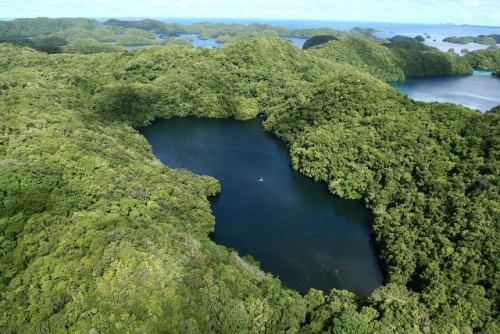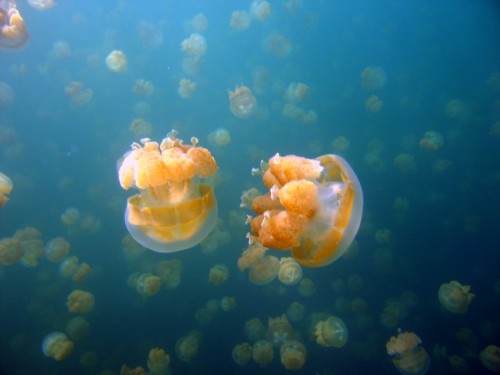Welcome to the Jellyfish Lake, Palau
Location:
In the south part of Palau on the island of Eil Malk, Oceania/Pacific.
Area/Surface:
57.000 m²
Cities:
Largest city is the capital Koror (45 min. boat ride) with around 11.000 inhabitants.
Average depth:
30 m
Maximum depth:
50 m
Elevation:
Sea level
Length:
460 m
Width:
160 m
When to go:
With an average temperature of 28° C throughout the year, Palau and Jellyfish Lake is best to be visited outside the rainy season between November and May-June.
How to get here:
By plane:
Because there are no roads on the Eil Malk island from Palau, you cannot get here by car or public transport. You must fly first to the International Koror Airport from the main island of Palau and then to take the boat. There are many flights during the week that come here from different parts of the world, but the best is to have a connection in Japan, South Korea, Australia or New Zealand.
By boat:
You can only get to Jellyfish Lake by a 45 minutes boat ride from Koror. Please check online as there are many companies offering day tours.
Jellyfish Lake, Palau
History, importance and name of Jellyfish Lake:
Jellyfish Lake from Palau is a once in a lifetime experience and a lifetime journey for every tourist. If you come in Palau for holiday or even just for business, you can’t miss this top tourist attraction. It’s situated in the south lagoon of this republic, on the island of Eil Malk. This small island is part of the group of islands called Rock Islands, a group of 445 islands which mostly are without any permanent residents. It’s said that the lake formed about 12.000 years ago when the sea level raised after the last glacier era. This lake is one of the 70 lakes from the Rock Islands and one of the 200 saline lakes in the world. Its importance is coming from the fact that here are normally living millions of tiny jellyfish of two different species.
It is a unique place and lake, a fantastic natural phenomenon and is easy to understand why is protected and famous in the world. The name is coming also from these millions of tiny creatures that populate the lake and are totally harmless. In the local language Jellyfish Lake is called Ongeim’l Tketau which means the Fifth Lake. Because there are no predators in the lake and these jellyfish are totally different than their relatives from the ocean, in time they lost their burning hairs, so that today visitors can swim with them without problems.
Relief, climate and the danger that threatens Jellyfish Lake:
The relief that surrounds Jellyfish Lake is amazing. As we mentioned before, it is situated on a rocky island, part of the Rock Islands UNESCO World Heritage. This island of just few meters above sea level, is covered with green vegetation and trees. You will have to hike for about 10 minutes to get from the boat to the lake. (Find more journeys on blog.worldlifetimejourneys.com). The climate in Palau is very warm throughout the year. An annual constant temperature of 30° C will make you feel great. The maximum temperatures during the dry season between November and May-June are around 32° C. On the other hand, the rainy season between June-July and October, brings for you lower temperatures of about 25-27° C. Even like this, you can enjoy this experience any time in the year.
The unique aspect for the lake is given also by the two layers that compose it. From the sea level until around 15-20 m depth, there is the oxygen layer. If you try to get under 15-20 m you will get to the second layer, an anoxic one made from hydrogene sulfide which is dangerous for humans. Unfortunately there is always something to disturb or kill the jellyfish. Besides tourists who don’t follow the rules and disturb or kill lake’s inhabitants, Jellyfish Lake is threatened by natural phenomenons. In the last years most of the jellyfish in the lake died and they need few years to recover. It is said that it’s because of the drought with the last years experiencing less rain than usual. Besides this, the hurricane El Nino affected as well bringing hotter temperatures than usual.

Airview of Jellyfish Lake from the Rock Islands, Republic of Palau
The types of jellyfish from Jellyfish Lake:
We told you that unfortunately most of the jellyfish died in the last year due to unnatural weather conditions. However, scientists hope that when the weather conditions will improve, the jellyfish will regenerate. These tiny creatures follow a daily habit to move from one side of Jellyfish Lake to the other daily. They follows the sun rays which in fact feed their algae living in their jelly. Most of the jellyfish from the lake are Golden Jellyfish. You must know that they are very similar to their ancestors from the ocean, the Spotted Jellyfish. However, they are totally missing the spots from their umbrella head and also the dangerous burning hairs.
They feed from the algae that are present in their jelly and also from zooplankton. They migrate for most of the day following the sun to feed their algae. In the night they usually stay in the western side of the lake. The other species present in Jellyfish Lake is the Moon Jellyfish. This species if part of the Aurelia genus. Comparative with the Golden Jellyfish, they do not have a specific pattern to follow. They feed during the night in comparison with the others, by coming to the surface of the water. Their main meal are the copepods which are small crustaceans found in the zooplankton.
Tourism and what you can see and do around Jellyfish Lake:
Most of the people on the planet never heard about Jellyfish Lake. Also, many never heard about Palau before or they don’t know where it is. Even like this, this unique in the world ecosystem brings from tourism a good profit to the Republic of Palau. During the years where millions of jellyfish swim in the lake, more than 160.000 tourists come here. They are attracted by the warm weather, the fantastic ecosystem and by the lifetime opportunity to swim with these creatures. To be able to get to the lake, all tourists are required to pay $100 for a permit that is valid 10 days. This permit will allow visitors to swim and/or snorkel with the jellyfish. Besides this fee, don’t forget you will need to pay for the boat tour to get you there and sometimes this can add another $100 per person.

Millions of Golden jellyfish swim daily from one side to the other of Jellyfish Lake
But, Jellyfish Lake is just one from the activities which you can do here. Palau is recognized as one of the best places for scuba diving, so many people come here for this. The best place you can go diving in Palau is the Blue Corner plateau that has strong currents. You can also go for a bird watching session or for a kayaking one (either day or night) which is very popular here. (Find more journeys on blog.worldlifetimejourneys.com). You can choose as well to cover yourself in a creamy therapeutic mud at famous Milky Way where most boats stop. You can rent a car or go with a tour to see Ngardmau Waterfall or the abandoned villages from Palau. Exploring the jungle is not easy, but it offers another experience. Whatever you choose to do, you will be totally satisfied. Visit Jellyfish Lake from Palau!




